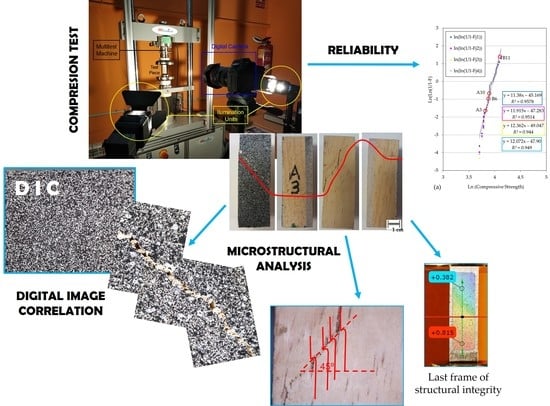Analysis of Mechanical Behavior through Digital Image Correlation and Reliability of Pinus halepensis Mill.
Abstract
:1. Introduction
1.1. Wood as Constructive Material
1.2. Mechanical Properties
1.3. DIC Technique
1.4. Reliability
2. Materials and Methods
2.1. Materials
2.2. Equipment and Methodology
2.3. Displacement Analysis
2.4. Strain’s Calculation
2.5. Obtaining the MOEc and MORc
2.6. Assessment of Reliability Using the Weibull Modulus Based on Compression Strength Data
2.7. Macroscopic and Microscopic Study
3. Results and Discussion
3.1. Determination of Reliability
3.2. Macroscopic and Microscopic Study
4. Conclusions
Author Contributions
Funding
Acknowledgments
Conflicts of Interest
References
- Saavedra Flores, E.I.; Dayyani, I.; Ajaj, R.M.; Castro-Triguero, R.; DiazDelao, F.A.; Das, R.; González Soto, P. Analysis of cross-laminated timber by computational homogenisation and experimental validation. Compos. Struct. 2015, 121, 386–394. [Google Scholar] [CrossRef]
- Morland, C.; Schier, F.; Janzen, N.; Weimar, H. Supply and demand functions for global wood markets: Specification and plausibility testing of econometric models within the global forest sector. For. Policy Econ. 2018, 92, 92–105. [Google Scholar] [CrossRef]
- Jonsson, R.; Rinaldi, F. The impact on global wood-product markets of increasing consumption of wood pellets within the European Union. Energy 2017, 133, 864–878. [Google Scholar] [CrossRef]
- Falk, R.H. Robert Wood as a Sustainable Building Material. J. For. Prod. 2009, 59, 6–12. [Google Scholar]
- Correal-Mòdol, E.; Vilches Casals, M. Properties of clear wood and structural timber of Pinus halepensis from north-eastern Spain. In Proceedings of the World Conference on Timber Engineering (WCTE), Auckland, New Zealand, 15–19 July 2012. [Google Scholar]
- Elaieb, M.T.; Shel, F.; Elouellani, S.; Janah, T.; Rahouti, M.; Thévenon, M.F.; Candelier, K. Physical, mechanical and natural durability properties of wood from reforestation Pinus halepensis Mill. in the Mediterranean Basin. Bois For. Trop. 2017, 1, 19–31. [Google Scholar] [CrossRef]
- Quinteros-Mayne, R.; de Arteaga, I.; Goñi-Lasheras, R.; Villarino, A.; Villarino, J.I. The influence of the elastic modulus on the finite element structural analysis of masonry arches. Constr. Build. Mater. 2019, 221, 614–626. [Google Scholar] [CrossRef]
- Cáceres Hidalgo, E. Caracterización Físico-Mecánica de la Madera de Paulownia Elongata; Universidad de Valladolid: Valladolid, Spain, 2016. [Google Scholar]
- European Standard. EN 1995-1-1 (2004): Eurocode 5: Design of Timberstructures-Part 1-1: General-Common Rules and Rules Forbuildings; European Committee of Standardization (CEN): Brussels, Belgium, 2004; p. 123. [Google Scholar]
- Spanish Standard. UNE 56535:1977 Características Físico-Mecánicas de la Madera; Asociación Española de Normalización (AENOR): Madrid, Spain, 2011. [Google Scholar]
- European Standard. EN 408+A1:2012. Timber Structures. Structural Timber and Glued Laminated Timber. Determination of Some Physical and Mechanical Properties; European Committee of Standardization (CEN): Brussels, Belgium, 2012. [Google Scholar]
- C, I.D.E.A.; Antonio, J.; Ordóñez, B.; Masera, O. Madera y Bosques. 2001. Available online: https://myb.ojs.inecol.mx/index.php/myb (accessed on 28 October 2020).
- Nogueira, M.; Ballarin, A.W. Sensibilidade dos ensaios de ultra-som à ortotropia elástica da madeira. In Proceedings of the Conferência Pan-Americana de Ensaios Não-Destrutivos, Salvador, Brazil, 25 May 2003; p. 3. [Google Scholar]
- Esteban, L.G.; de Palacios, P.; García Fernández, F.; García-Iruela, A.; del Pozo, J.C.; Pérez Borrego, V.; Agulló Pérez, J.; Padrón Cedrés, E.; Arriaga, F. Characterisation of Pinus canariensis C.Sm. ex DC. Sawn Timber from Reforested Trees on the Island of Tenerife, Spain. Forests 2020, 11, 769. [Google Scholar] [CrossRef]
- Šilinskas, B.; Varnagiryte-Kabašinskiene, I.; Aleinikovas, M.; Beniušiene, L.; Aleinikoviene, J.; Škema, M. Scots pine and norway spruce wood properties at sites with different stand densities. Forests 2020, 11, 587. [Google Scholar] [CrossRef]
- Argüelles Álvarez, F.R.; Arriaga Martitegui, M.; Esteban Herrero, G.Í.; González, R.A.B. Estructuras de Madera Bases de Cálculo; AITIM: Madrid, Spain, 2013. [Google Scholar]
- Baño, V.; Cetrangolo, G.; Morquio Hugo O’Neill, A. Stress-strain diagram of free-defects timber of pinus elliottii from Uruguay. In Proceedings of the XXXVI Jornadas Sudamericanas de Ingeniería Estructural, Montevideo, Uruguay, 19–21 November 2014. [Google Scholar]
- Moya, L.; Baño, V. Elastic behavior of fast-growth Uruguayan pine determined from compression and bending tests. BioRes 2017, 12, 5896–5912. [Google Scholar] [CrossRef] [Green Version]
- Bucur, V. Acoustic of Wood. In Acoustics of Wood; Springer: Berlin/Heidelberg, Germany, 2006; pp. 1–4. ISBN 978-3-540-26123-0. [Google Scholar]
- Álvaro Pérez Ortega Comparación de Ensayos a Compresión de Madera Estructural Mediante Norma UNE y Norma ASTM; Universidad de Valladolid: Valladolid, Spain, 2014.
- Sutton, M.; Orteu, J.; Schreier, H. Image Correlation for Shape, Motion and Deformation Measurements: Basic Concepts, Theory and Applications; Springer Science & Business Media: Berlin/Heidelberg, Germany, 2009. [Google Scholar]
- Pan, B.; Qian, K.; Xie, H.; Asundi, A. Two-dimensional digital image correlation for in-plane displacement and strain measurement: A review. Meas. Sci. Technol. 2009, 20, 062001. [Google Scholar] [CrossRef]
- Allaoui, S.; Rekik, A.; Gasser, A.; Blond, E.; Andreev, K. Digital Image Correlation measurements of mortarless joint closure in refractory masonries. Constr. Build. Mater. 2018, 162, 334–344. [Google Scholar] [CrossRef]
- Sánchez-Aparicio, L.J.; Villarino, A.; García-Gago, J.; González-Aguilera, D. Photogrammetric, geometrical, and numerical strategies to evaluate initial and scurrent conditions in historical constructions: A test case in the church of San Lorenzo (Zamora, Spain). Remote Sens. 2016, 8, 60. [Google Scholar] [CrossRef] [Green Version]
- García-Martin, R.; López-Rebollo, J.; Sánchez-Aparicio, L.J.; Fueyo, J.G.; Pisonero, J.; González-Aguilera, D. Digital image correlation and reliability-based methods for the design and repair of pressure pipes through composite solutions. Constr. Build. Mater. 2020, 248, 118625. [Google Scholar] [CrossRef]
- Fayyad, T.M.; Lees, J.M. Application of Digital Image Correlation to Reinforced Concrete Fracture. Procedia Mater. Sci. 2014, 3, 1585–1590. [Google Scholar] [CrossRef] [Green Version]
- Aghlara, R.; Tahir, M.M. Measurement of strain on concrete using an ordinary digital camera. Meas. J. Int. Meas. Confed. 2018, 126, 398–404. [Google Scholar] [CrossRef]
- Krishnan, S.A.; Moitra, A.; Sasikala, G.; Baranwal, A.; Moitra, A.; Sasikala, G.; Albert, S.K.; Bhaduri, A.K.; Harmain, G.A.; Jayakumar, T.; et al. Assessment of Deformation Field during High Strain Rate Tensile Tests of RAFM Steel Using DIC Technique. Procedia Eng. 2014, 86, 131–138. [Google Scholar] [CrossRef] [Green Version]
- Guo, N.; Liang, J.; Yu, Q.; Qian, B. Plastic evolution behavior of H340LAD_Z steel by an optical method. Phys. B Condens. Matter 2017, 506, 69–74. [Google Scholar] [CrossRef]
- López-Alba, E.; López-García, R.; Dorado, R.; Díaz, F.A. Aplicación de correlación digital de imágenes para el análisis de problemas de contacto. In Proceedings of the XIX Congreso Nacional de Ingeniería Mecánica, Castellón de la Plana, Spain, 15–16 November 2012; p. 8. [Google Scholar]
- Pablo Canal Casado, L. Experimental and Computational Micromechanical Study of Fiber-Reinforced Polymers; Universidad Politécnica de Madrid: Madrid, Spain, 2011. [Google Scholar]
- Sabato, A.; Niezrecki, C. Feasibility of digital image correlation for railroad tie inspection and ballast support assessment. Meas. J. Int. Meas. Confed. 2017, 103, 93–105. [Google Scholar] [CrossRef]
- Zink, A.G.; Hanna, R.B.; Stelmokas, J.W. Measurement of Poisson’s ratios for yellow-poplar. For. Prod. J. 1997, 47, 78–80. [Google Scholar]
- Bjurhager, I.; Berglund, L.A.; Bardage, S.L.; Sundberg, B. Mechanical characterization of juvenile European aspen (Populus tremula) and hybrid aspen (Populus tremula × Populus tremuloides) using full-field strain measurements. J. Wood Sci. 2008, 54, 349–355. [Google Scholar] [CrossRef]
- Jeong, G.Y.; Hindman, D.P.; Zink-Sharp, A. Orthotropic properties of loblolly pine (Pinus taeda) strands. J. Mater. Sci. 2010, 45, 5820–5830. [Google Scholar] [CrossRef]
- Jeong, G.Y.; Park, M.J. Evaluate orthotropic properties of wood using digital image correlation. Constr. Build. Mater. 2016, 113, 864–869. [Google Scholar] [CrossRef]
- Guindos, P.; Ortiz, J. The utility of low-cost photogrammetry for stiffness analysis and finite-element validation of wood with knots in bending. Biosyst. Eng. 2013, 114, 86–96. [Google Scholar] [CrossRef]
- Kunecký, J.; Sebera, V.; Hasníková, H.; Arciszewska-Kędzior, A.; Tippner, J.; Kloiber, M. Experimental assessment of a full-scale lap scarf timber joint accompanied by a finite element analysis and digital image correlation. Constr. Build. Mater. 2015, 76, 24–33. [Google Scholar] [CrossRef]
- Méité, M.; Dubois, F.; Pop, O.; Absi, J. Mixed mode fracture properties characterization for wood by Digital Images Correlation and Finite Element Method coupling. Eng. Fract. Mech. 2013, 105, 86–100. [Google Scholar] [CrossRef]
- Ritschel, F.; Zhou, Y.; Brunner, A.J.; Fillbrandt, T.; Niemz, P. Acoustic emission analysis of industrial plywood materials exposed to destructive tensile load. Wood Sci. Technol. 2014, 48, 611–631. [Google Scholar] [CrossRef] [Green Version]
- Jeong, G.Y.; Zink-Sharp, A.; Hindman, D.P. Applying digital image correlation to wood strands: Influence of loading rate and specimen thickness. Holzforschung 2010, 64, 729–734. [Google Scholar] [CrossRef]
- Liu, J.Y. A weibull analysis of wood member bending strength. J. Mech. Des. Trans. ASME 1982, 104, 572–577. [Google Scholar] [CrossRef]
- Zhong, Y.; Wu, G.; Ren, H.; Jiang, Z. A determination method of compressive design value of dimensional lumber. J. Wood Sci. 2018, 64, 526–537. [Google Scholar] [CrossRef] [Green Version]
- Owens, F.C.; Verrill, S.P.; Shmulsky, R.; Kretschmann, D.E. Distributions of moe and mor in a full lumber population. Wood Fiber Sci. 2018, 50, 265–279. [Google Scholar] [CrossRef] [Green Version]
- Ono, K. A simple estimation method of Weibull modulus and verification with strength data. Appl. Sci. 2019, 9, 1575. [Google Scholar] [CrossRef] [Green Version]
- Antón, N.; Velasco, F.; Gordo, E.; Torralba, J.M. Statistical approach to mechanical behaviour of ceramic matrix composites based on Portland clinker. Ceram. Int. 2001, 27, 391–399. [Google Scholar] [CrossRef]
- Matos, P.J.L. Caracterización Físico-Mecánica de la Madera de Pinus Halepensis Mill. Variación axial y radial de las Propiedades en la región de Procedencia Ibérica 9; Escuela Técnica Superior de Ingeniería de Montes, Forestal y del Medio Rural; Universidad Politécnica de Madrid: Madrid, Spain, 2017. [Google Scholar]
- Pan, B.; Lu, Z.; Xie, H. Mean intensity gradient: An effective global parameter for quality assessment of the speckle patterns used in digital image correlation. Opt. Lasers Eng. 2010, 48, 469–477. [Google Scholar] [CrossRef]
- Contenido de Humedad de una Pieza de Madera Aserrada. In Parte 1: Determinación por el Método de Secado en Estufa; UNE EN 13183-1/AC (AENOR, 2004); UNE: Armidale, Australia, 2004; Available online: https://www.en.une.org/encuentra-tu-norma/busca-tu-norma/norma?c=N0027392 (accessed on 28 October 2020).
- GOM Correlate 2D 2016. Available online: https://www.gom.com/3d-software/gom-correlate.html (accessed on 28 October 2020).
- Baño, V.; Bustillo, R.A.; Regueira, R.; Fernández, M.G. Determinación de la curva tensión-deformación en madera de Pinus sylvestris L. para la simulación numérica de vigas de madera libre de defectos. Materiales Construcción 2012, 306, 269–284. [Google Scholar] [CrossRef] [Green Version]
- Hernández-Maldonado, S.A.; Sotomayor-Castellanos, J.R. Elastic behavior of Acer rubrum and Abies balsamea wood. Madera Bosques 2014, 20, 113–123. [Google Scholar] [CrossRef]
- Martin, C.L.; Bouvard, D.; Delette, G. Discrete element simulations of the compaction of aggregated ceramic powders. J. Am. Ceram. Soc. 2006, 89, 3379–3387. [Google Scholar] [CrossRef]
- Kang, D.; Ko, K.; Huh, J. Comparative study of different methods for estimatingweibull parameters: A case study on Jeju Island, South Korea. Energies 2018, 11, 356. [Google Scholar] [CrossRef] [Green Version]
- Lamon, J. Statistical-Probabilistic Approaches to Brittle Fracture: The Weibull Model. In Brittle Fract. Damage Brittle Mater. Compos, 1st ed.; ISTE Press–Elsevier: Amsterdam, The Netherlands, 2016; pp. 35–49. ISBN 9781785481215. [Google Scholar]
- Antón, N.; González-Fernández, Á.; Villarino, A. Reliability and Mechanical Properties of Materials Recycled from Multilayer Flexible Packages. Materials 2020, 13, 3992. [Google Scholar] [CrossRef]
- Danzer, R.; Schubert, H.; Petzow, G. Statistical treatment of brittle fracture and tensile testing of ceramics. Int. Conf. Powder Metall. 1990, 2, 118–123. [Google Scholar]
- Rasband, W.S. Imaging Processing and Analysis in Java ImageJ. ASCL 2012, ascl-1206, 013. [Google Scholar]
- García Esteban, L.; de Palacios de Palacios, P. La madera del pino carrasco (Pinus halepensis Mill.). Cuad. Soc. Española Cienc. For. 2000, 10. [Google Scholar] [CrossRef]
- CTFC- Centre Tecnològic Forestal de Catalunya; WOODTECH Proyect: Cataluña, Spain, 2014.
- Serrada, R.; Montero, G.; Reque, J.A. Compendio de selvicultura aplicada en España; No. 634.95 C737; Instituto Nacional de Investigación y Tecnología Agraria y Alimentaria, Ministerio de Educación y Ciencia: Madrid, Spain, 2008. [Google Scholar]
- Lee, S. Estimation and Comparison of Weibull Parameters for Reliability Assessments of Douglas-fir wood. Int. J. Basic Appl. Sci. 2014, 14, 18–21. [Google Scholar]

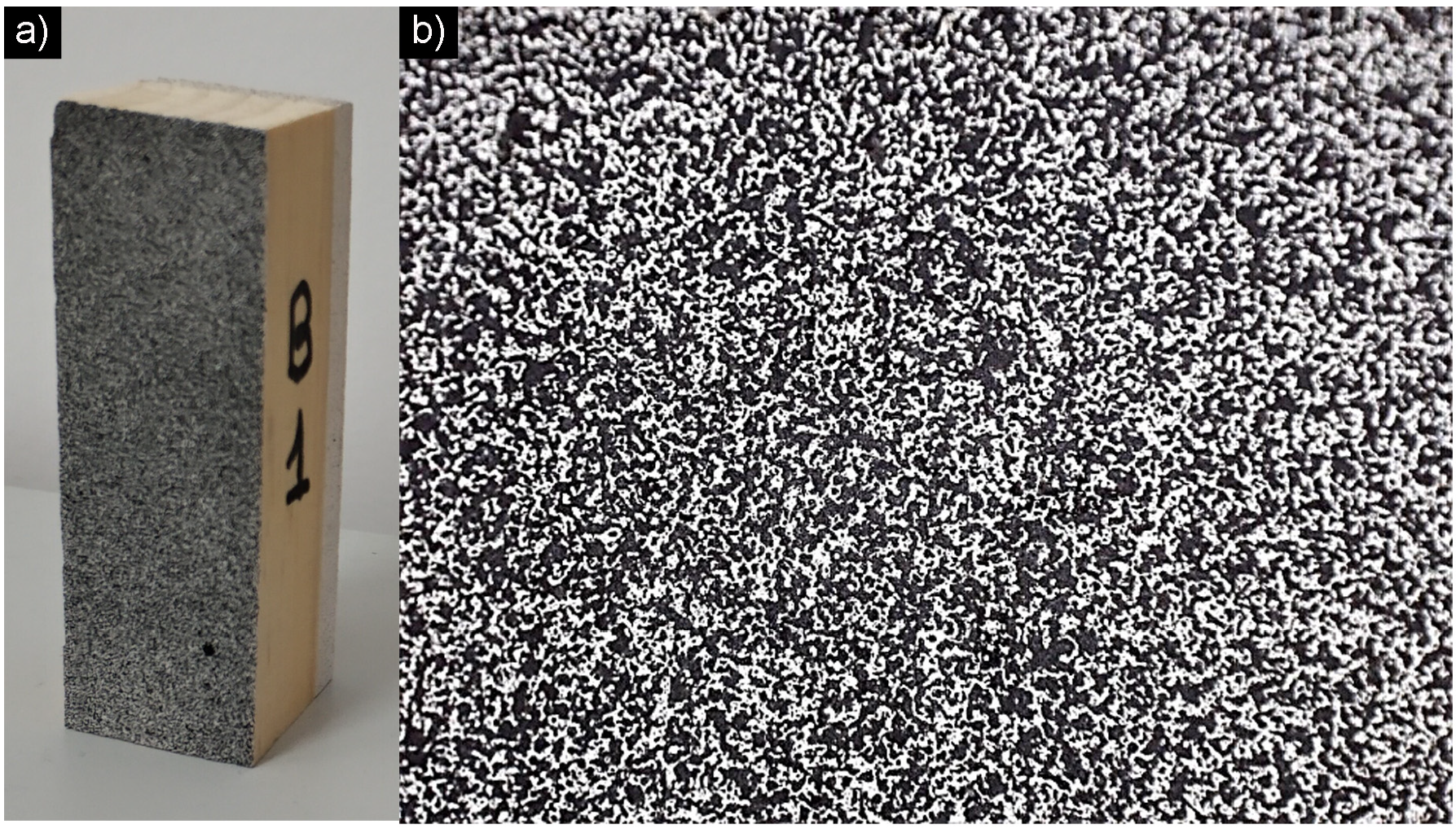
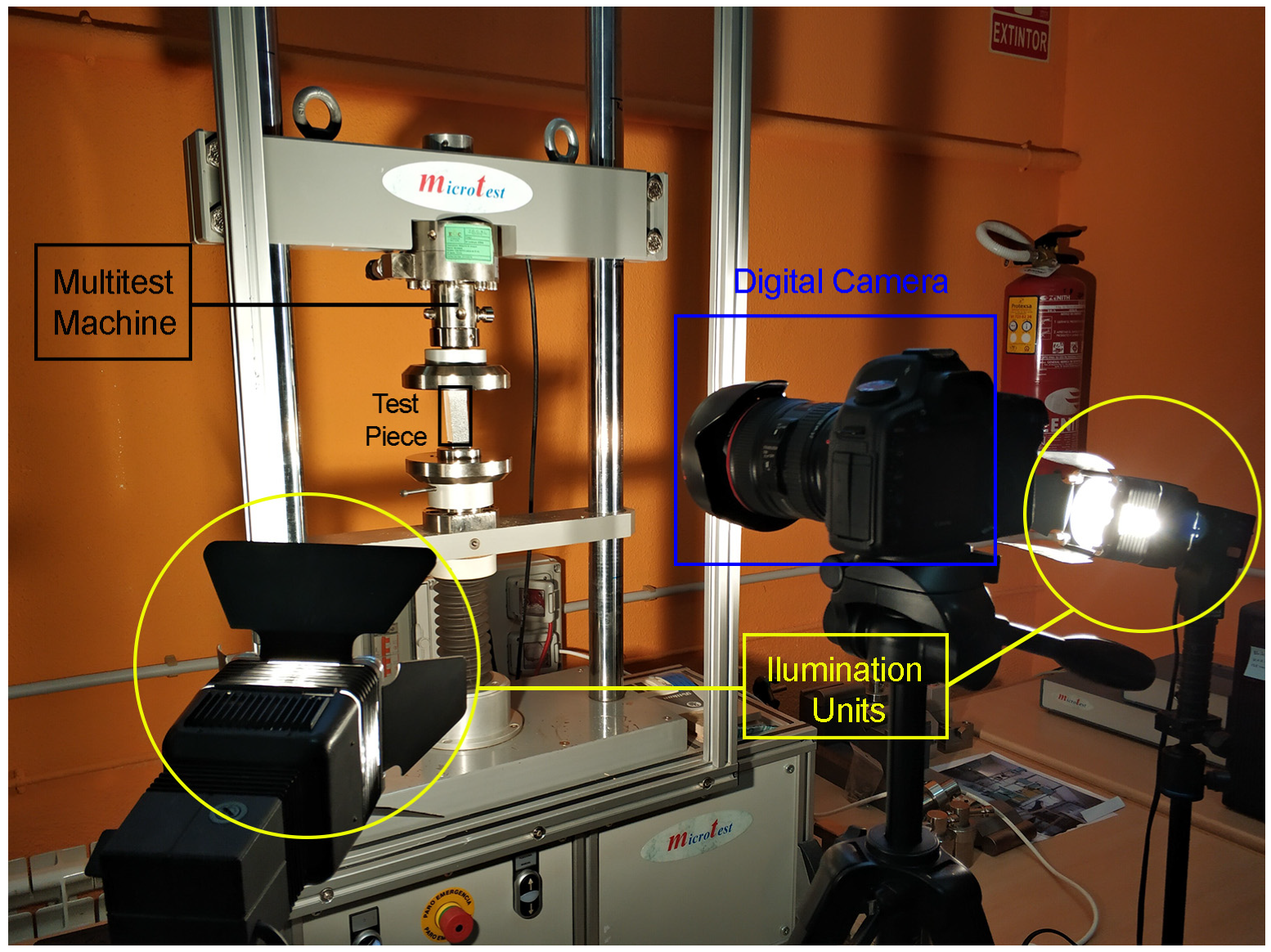
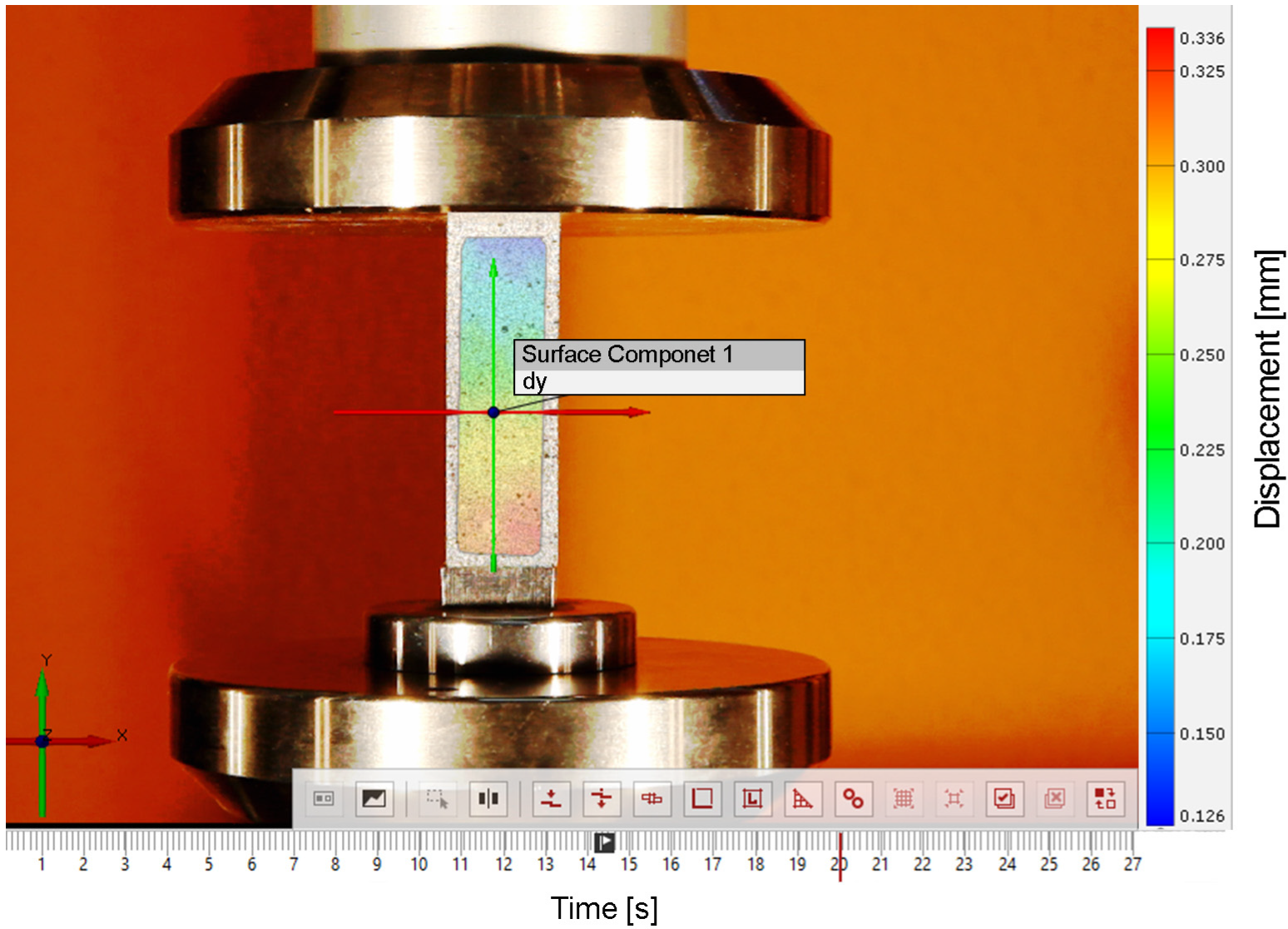
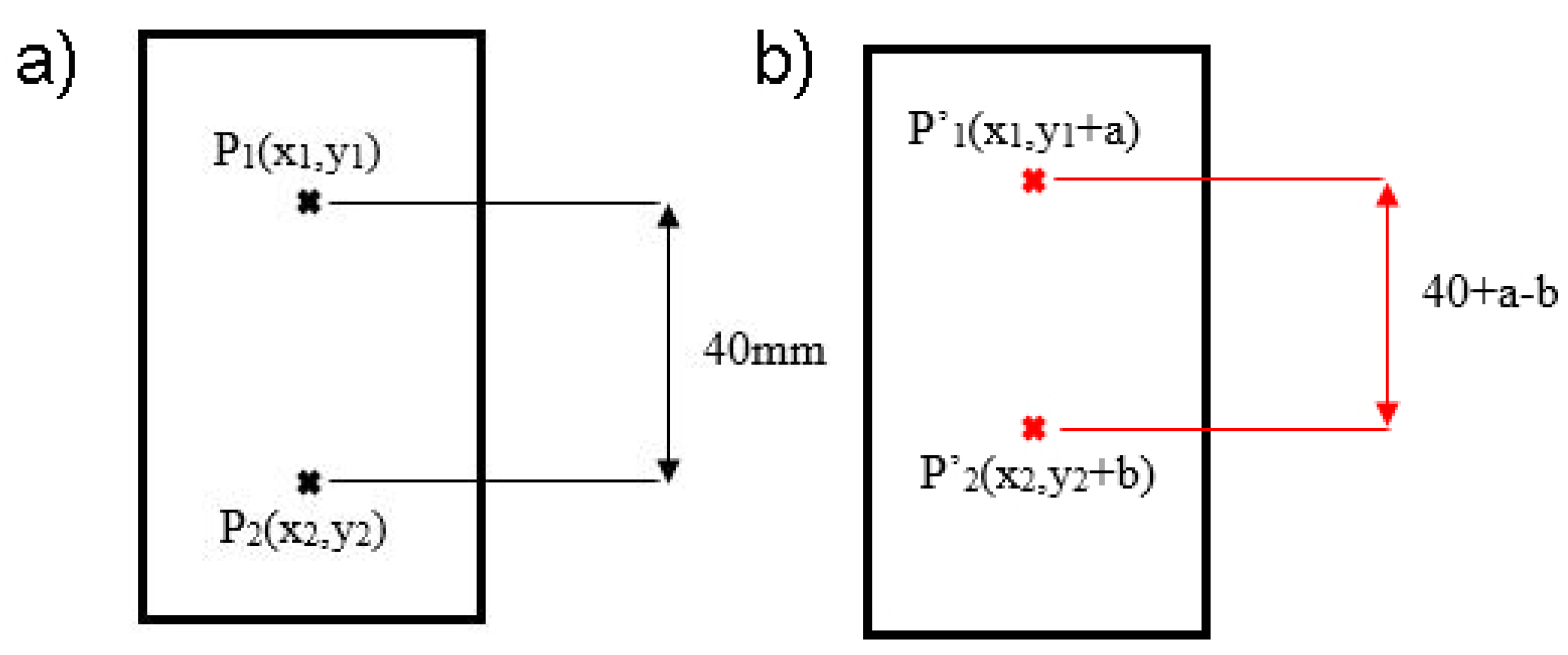
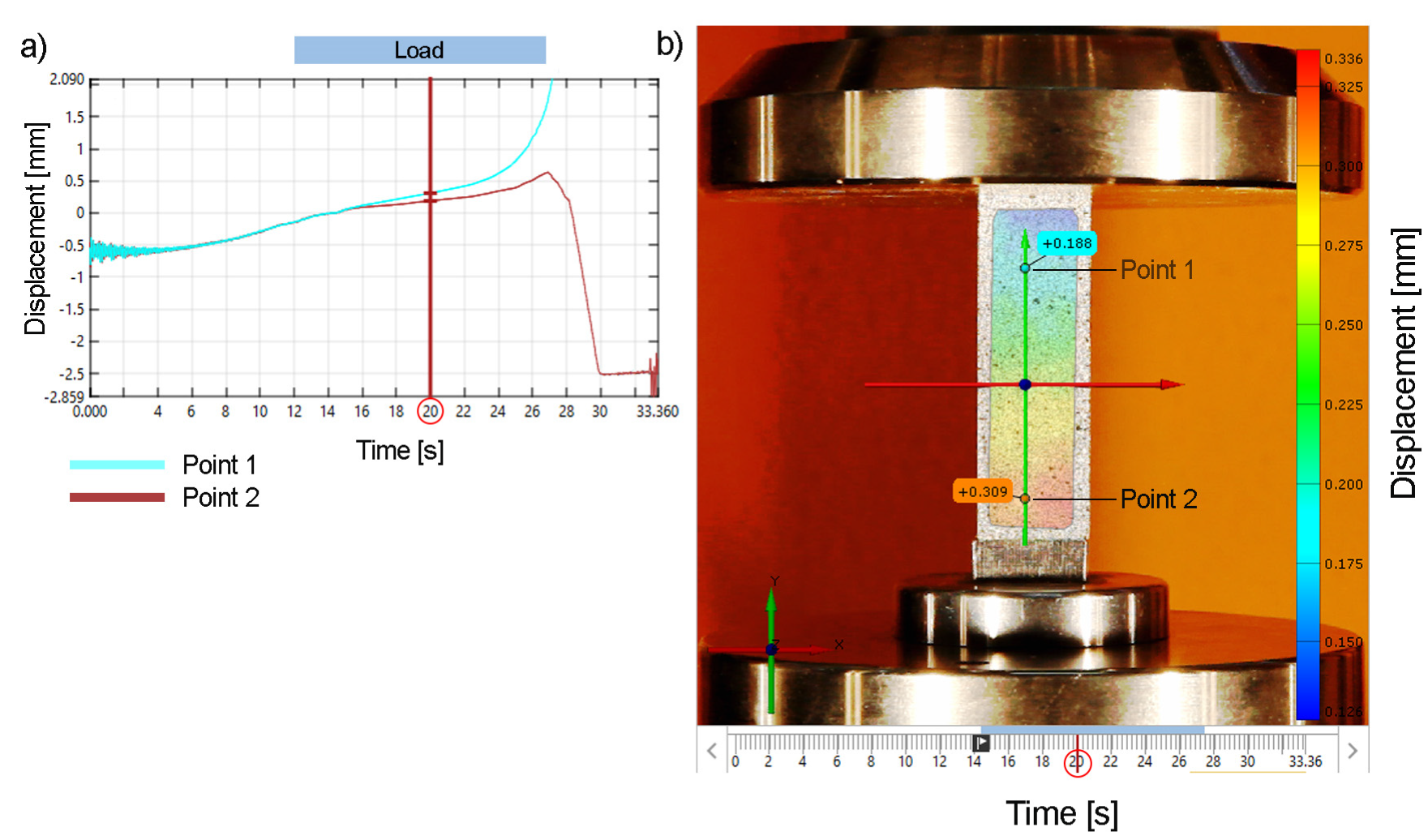
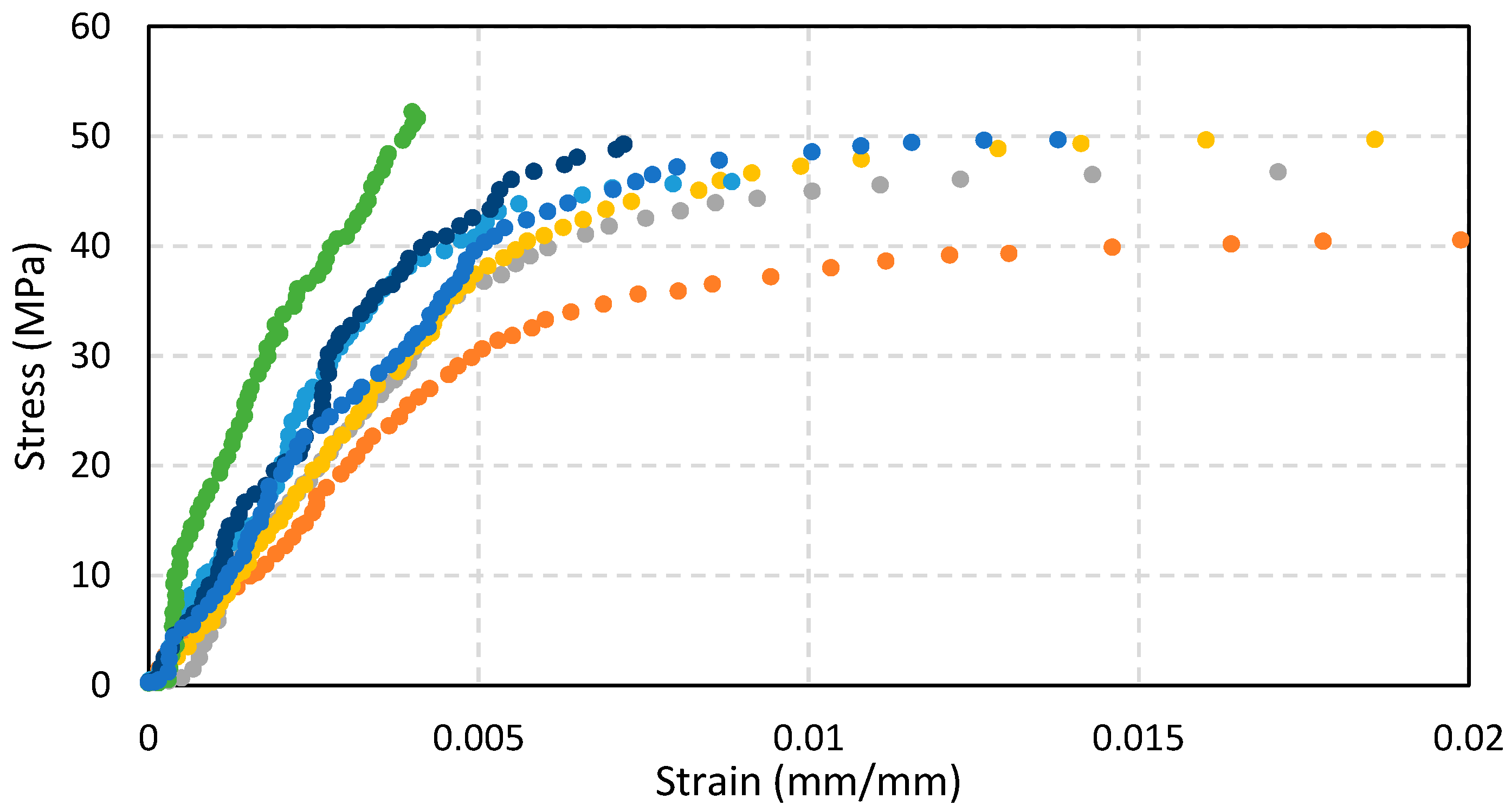
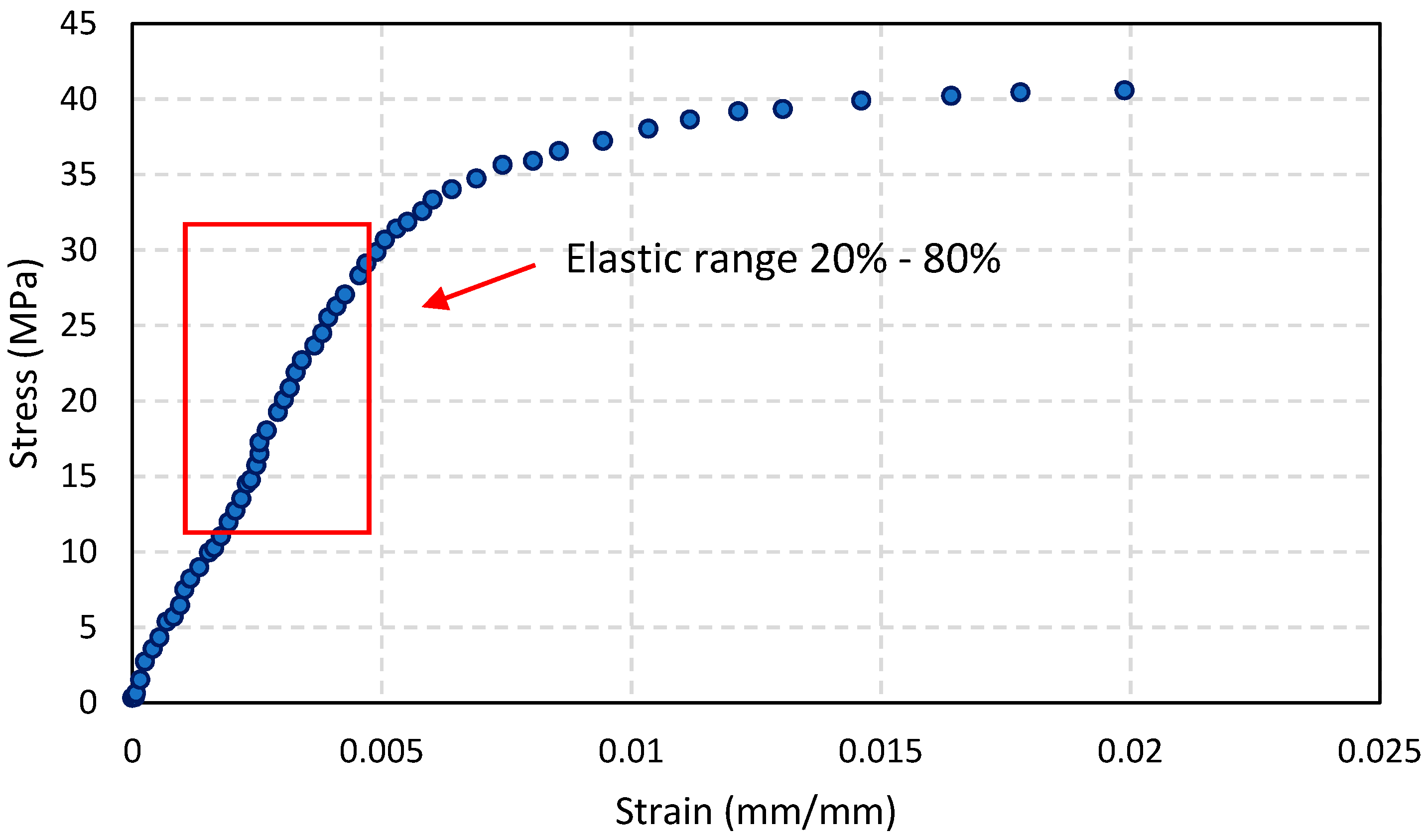
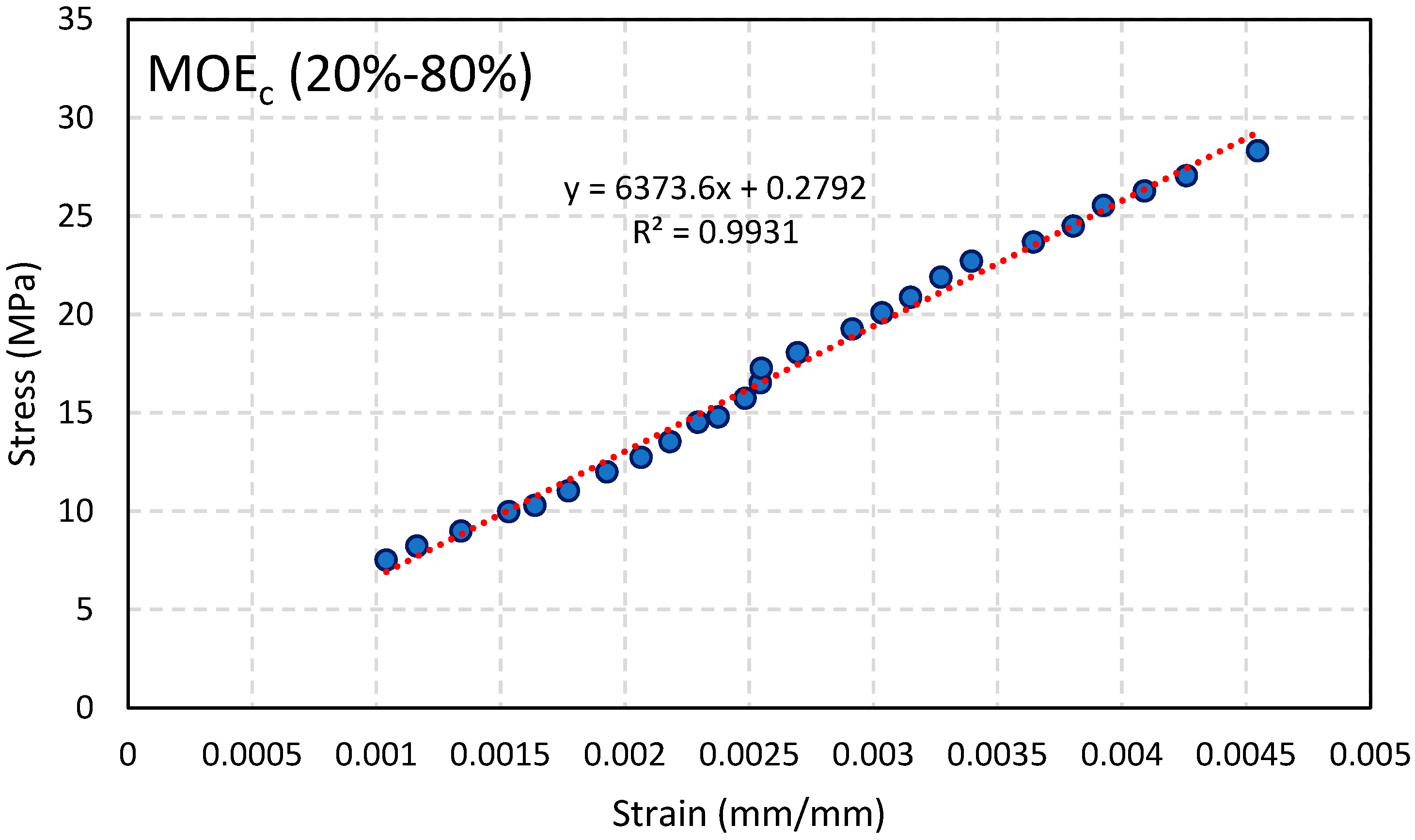


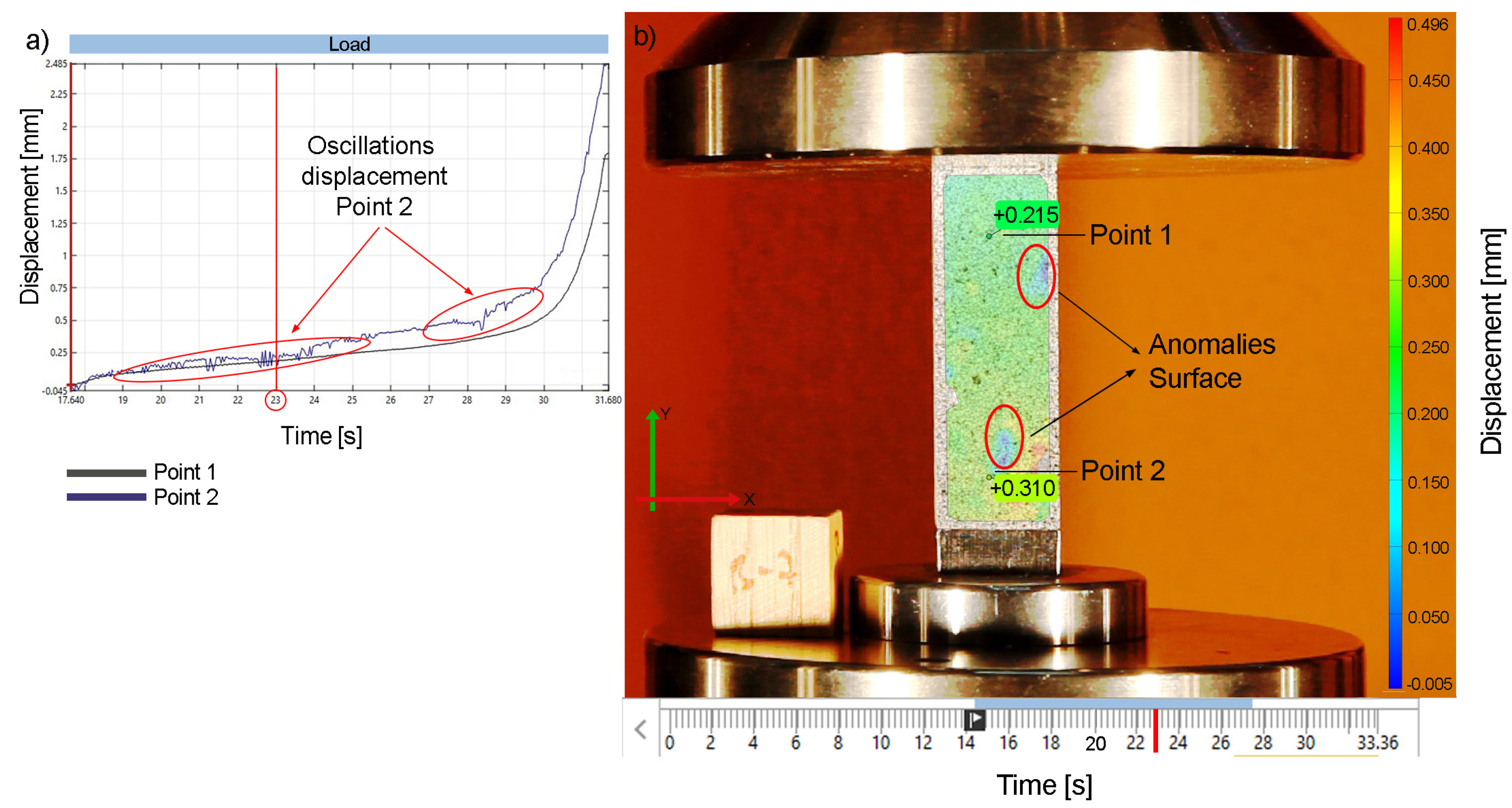
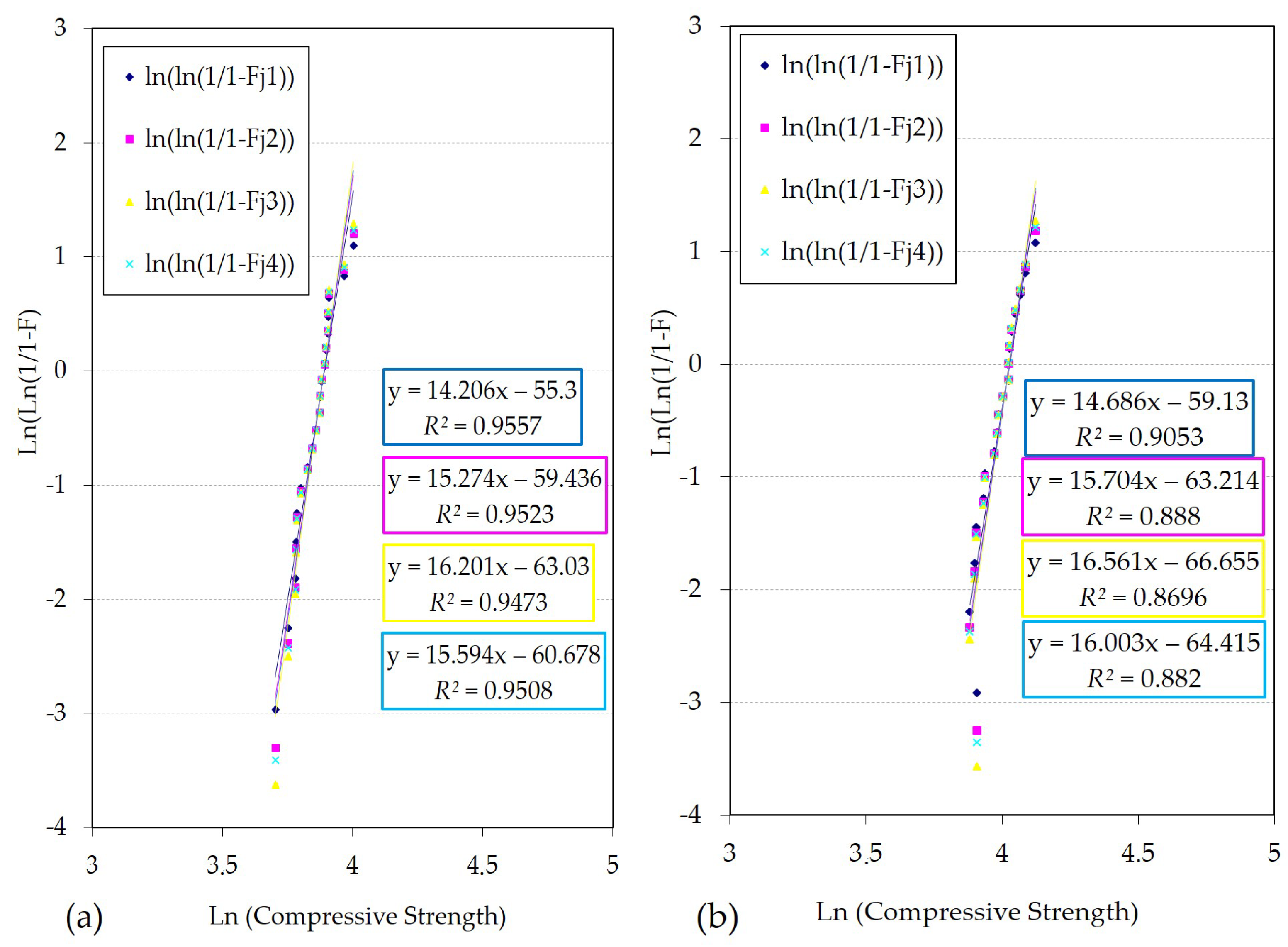
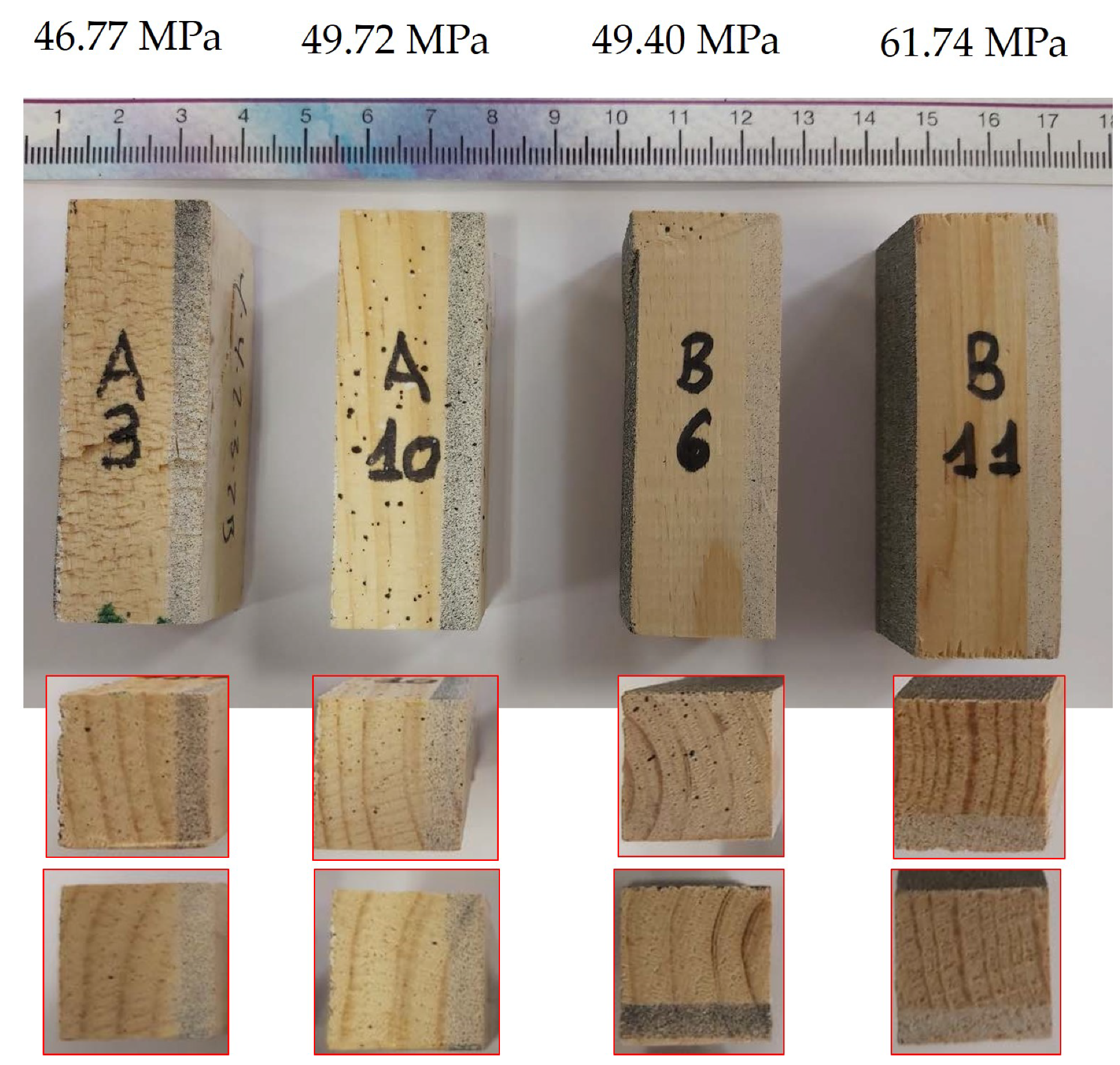




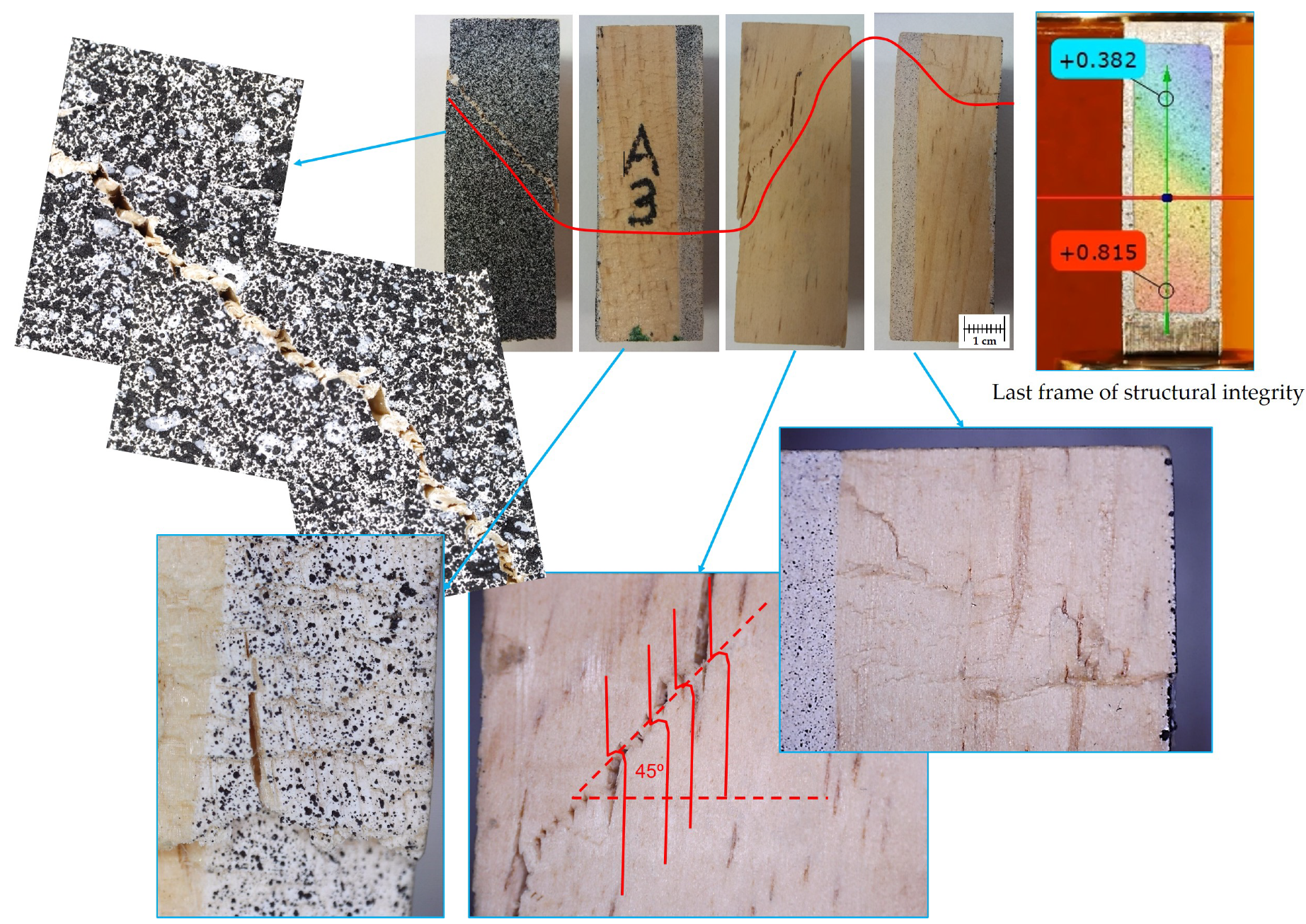

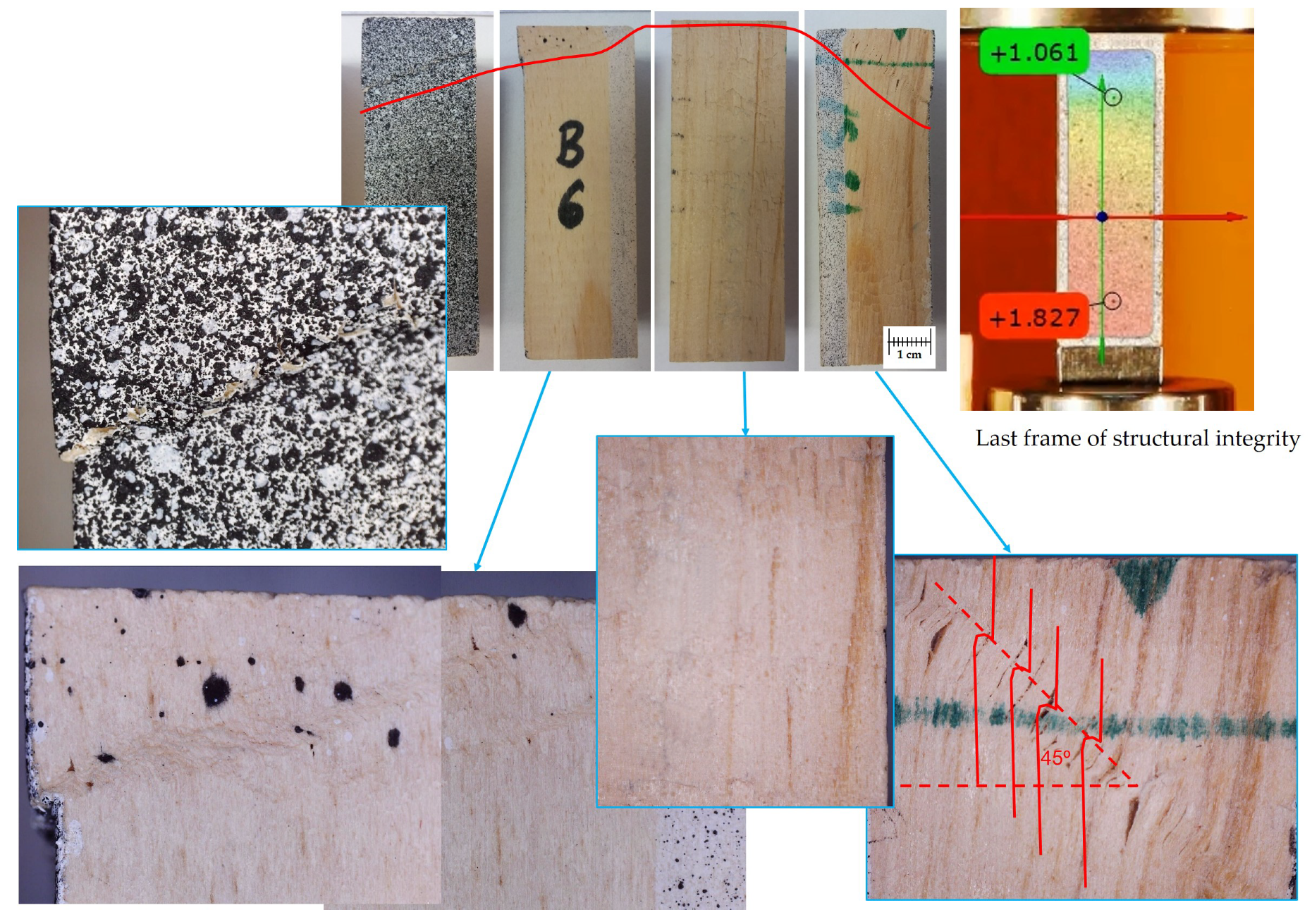
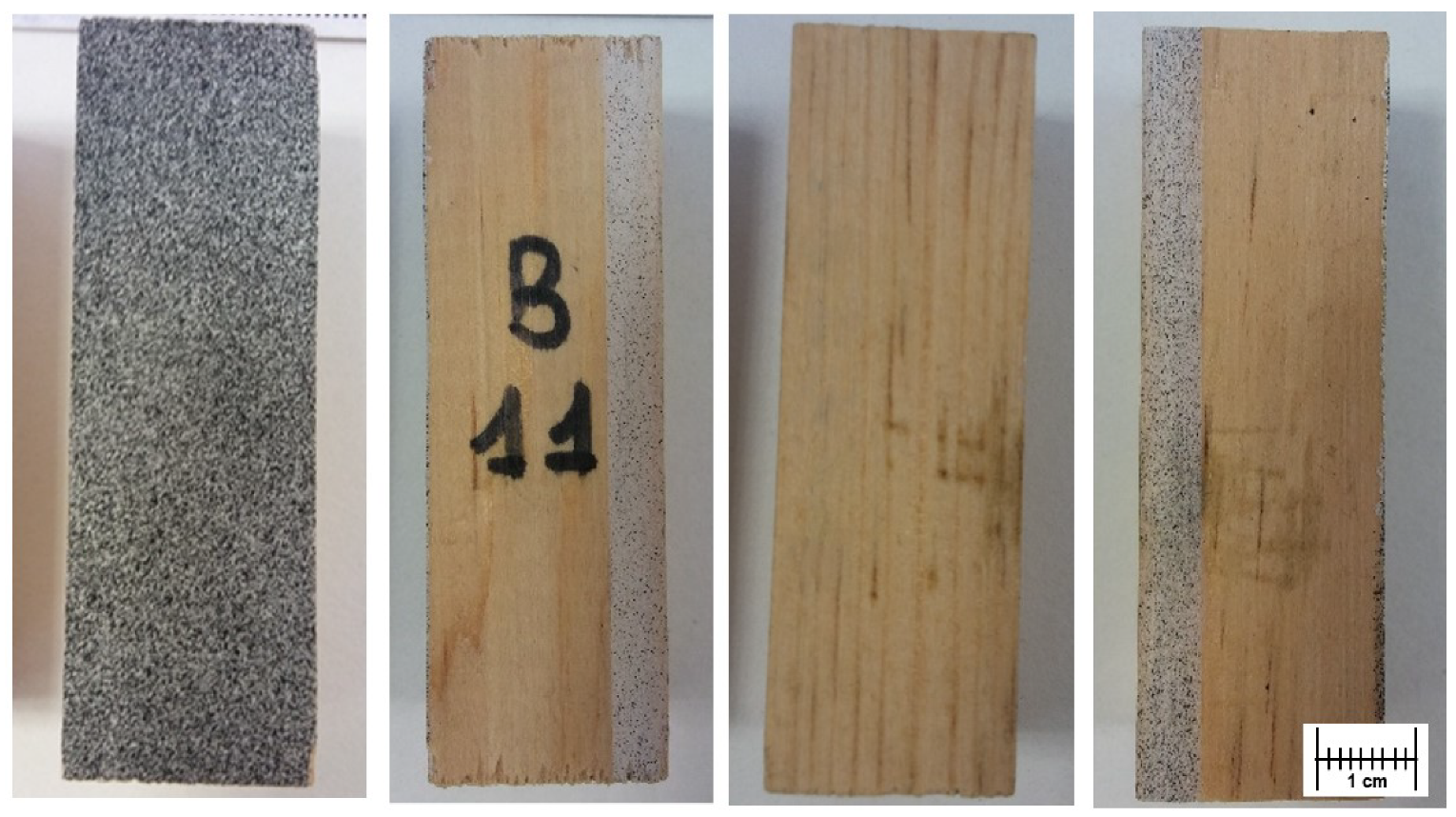
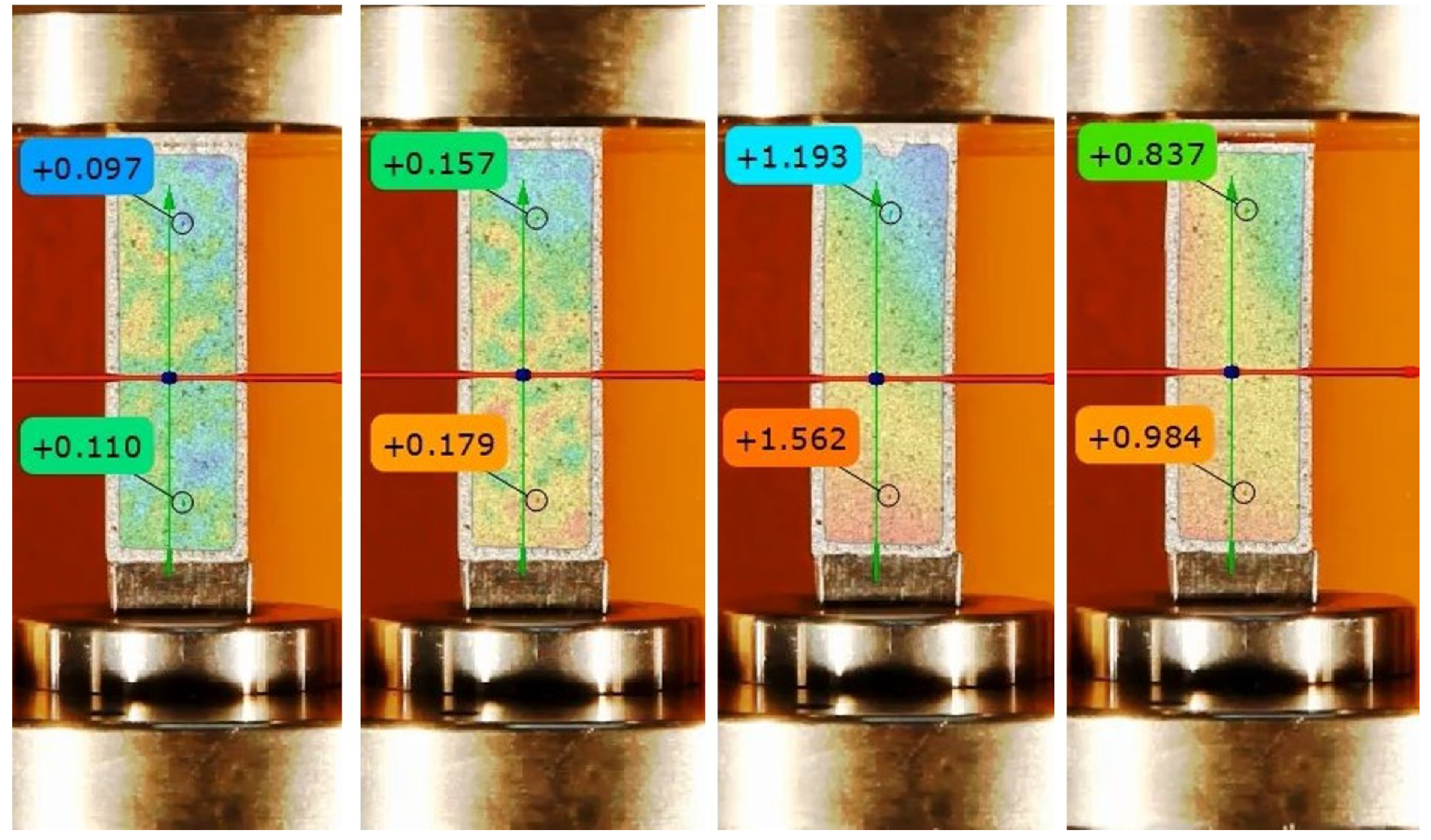
| Tree (Serial) | Basal Diameter (m) | Normal Diameter (m) | Height (m) | No. log |
|---|---|---|---|---|
| A | 0.47 | 0.45 | 15.80 | 4 |
| B | 0.52 | 0.50 | 14.70 | 4 |
| CANON EOS 5D MARK II | |||
|---|---|---|---|
| Sensor type | CMOS | Video size | 1920 × 1080 px |
| Sensor size | 24 × 36 mm2 | Video frames | 25 fps |
| Image size | 5616 × 3744 px | Video type | MOV |
| Total pixels | 22 Mpx | Lens magnification | 1.0 × (life size) |
| Image type | RAW | Dimensions | 152 × 113.5 × 75 mm |
| Parallel Compression of Fibers | |||||
| Samples | MORc (MPa) | MOEc (MPa) | Standard Deviation MORc (MPa) | Standard Deviation MOEc (MPa) | |
| Average A | 19 | 47.39 | 9072 | 3.53 | 2304 |
| Average B | 18 | 54.23 | 10,348 | 3.80 | 1940 |
| Total Average | 37 | 50.72 | 9693 | 5.00 | 2202 |
| Samples | Density (kg/m3) | Standard Deviation density (kg/m3) | Ring width (mm) | Standard Deviation ring width (mm) | |
| Average A | 19 | 561 | 33 | 3.04 | 0.61 |
| Average B | 18 | 597 | 34 | 2.93 | 1.30 |
| Total Average | 37 | 579 | 38 | 2.99 | 1.00 |
| MORc (MPa) | MOEc (MPa) | |||
|---|---|---|---|---|
| Total (37 samples) | Linear regression | R² | Linear regression | R2 |
| Density (kg/m3) | y = 0.0972x − 5.5492 | 0.541 | y = 16.582x + 95.762 | 0.0812 |
| Ring width (mm) | y = −2.1901x + 57.101 | 0.1585 | y = −879.66x + 12,256 | 0.1319 |
| Linear Regression | R2 | Characteristic Strength (MORc) | Weibull Modulus |
|---|---|---|---|
| y = 11.380 x − 45.169 | 0.9578 | 52.94 | 11.380 |
| y = 11.915 x − 47.283 | 0.9514 | 52.90 | 11.915 |
| y = 12.362 x − 49.047 | 0.9440 | 52.85 | 12.362 |
| y = 12.072 x − 47.900 | 0.9490 | 52.87 | 12.072 |
Publisher’s Note: MDPI stays neutral with regard to jurisdictional claims in published maps and institutional affiliations. |
© 2020 by the authors. Licensee MDPI, Basel, Switzerland. This article is an open access article distributed under the terms and conditions of the Creative Commons Attribution (CC BY) license (http://creativecommons.org/licenses/by/4.0/).
Share and Cite
Villarino, A.; López-Rebollo, J.; Antón, N. Analysis of Mechanical Behavior through Digital Image Correlation and Reliability of Pinus halepensis Mill. Forests 2020, 11, 1232. https://doi.org/10.3390/f11111232
Villarino A, López-Rebollo J, Antón N. Analysis of Mechanical Behavior through Digital Image Correlation and Reliability of Pinus halepensis Mill. Forests. 2020; 11(11):1232. https://doi.org/10.3390/f11111232
Chicago/Turabian StyleVillarino, Alberto, Jorge López-Rebollo, and Natividad Antón. 2020. "Analysis of Mechanical Behavior through Digital Image Correlation and Reliability of Pinus halepensis Mill." Forests 11, no. 11: 1232. https://doi.org/10.3390/f11111232




